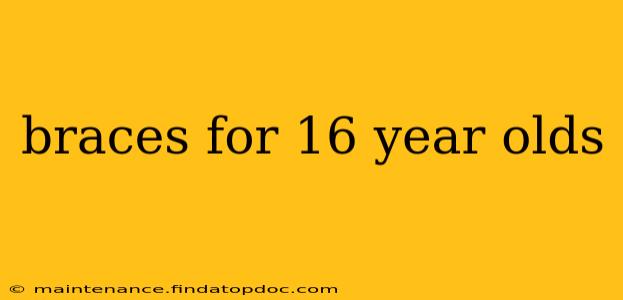For many teenagers, the age of 16 marks a significant milestone – driving, socializing, and, for some, the beginning of orthodontic treatment with braces. This comprehensive guide will delve into the world of braces for 16-year-olds, addressing common questions and concerns. We'll cover everything from the necessity of treatment to the different types of braces available and what to expect during the process.
Why Do 16-Year-Olds Need Braces?
Many factors contribute to the decision to get braces at age 16. While some teens may have begun orthodontic treatment earlier, others may be starting later due to various reasons. Common reasons include:
- Crowded Teeth: Overcrowding can lead to difficulty cleaning teeth, increasing the risk of cavities and gum disease. Braces realign the teeth to create space and improve oral hygiene.
- Overbite/Underbite: Severe overbites or underbites can affect chewing, speech, and jaw joint health. Braces correct these malocclusions, improving both function and aesthetics.
- Crossbite: A crossbite occurs when the upper teeth sit inside the lower teeth. This can lead to uneven jaw growth and facial asymmetry. Braces correct the bite to improve function and appearance.
- Gaps Between Teeth (Diastema): While some find gaps charming, significant gaps can affect speech and self-esteem. Braces close these gaps for a more aligned smile.
- Improving Aesthetics: Straightening teeth improves the overall appearance of the smile, boosting confidence and self-esteem.
What Types of Braces Are Available for 16-Year-Olds?
Several types of braces are available, each with its own advantages and disadvantages:
- Traditional Metal Braces: These are the most common and generally the most affordable option. They are effective and durable, offering a reliable method for straightening teeth.
- Ceramic Braces: These braces use tooth-colored brackets, making them less noticeable than metal braces. They are more aesthetically pleasing but can be more prone to staining and slightly more expensive.
- Lingual Braces: These are placed on the back of the teeth, making them completely invisible. However, they can be more uncomfortable initially and may require more adjustments.
- Invisalign: This is a clear aligner system that uses a series of custom-made trays to gradually move the teeth. Invisalign is less noticeable than traditional braces but may not be suitable for all cases.
How Long Does Braces Treatment Take at Age 16?
The duration of braces treatment varies significantly depending on the complexity of the case. For a 16-year-old, treatment could last anywhere from 12 to 36 months. Regular check-ups with the orthodontist are crucial for monitoring progress and making necessary adjustments.
What Is the Cost of Braces for a 16-Year-Old?
The cost of braces can vary widely depending on the type of braces chosen, the complexity of the treatment, and the orthodontist's fees. It's essential to discuss payment plans and financing options with the orthodontist's office during the initial consultation.
How Do I Care for My Teeth While Wearing Braces?
Maintaining good oral hygiene is paramount while wearing braces. This involves:
- Brushing: Brush your teeth thoroughly at least twice a day with a fluoride toothpaste, paying special attention to the areas around the brackets and wires. Consider using an interdental brush or floss threader to clean between the teeth and under the wires.
- Flossing: Flossing is crucial to remove food particles and plaque that brushing may miss.
- Mouthwash: Using a fluoride mouthwash can help further strengthen teeth and prevent cavities.
- Regular Dental Check-ups: Maintain regular visits to your dentist and orthodontist for check-ups and cleanings.
Are There Any Risks or Side Effects Associated with Braces?
While generally safe, braces can have some minor side effects:
- Discomfort: Some initial discomfort is normal, but pain relievers can help manage it.
- Irritation: The brackets and wires may cause minor irritation to the gums and cheeks. Wax can be used to protect these areas.
- Food Restrictions: Certain foods, such as hard candies and sticky sweets, should be avoided to prevent damage to the braces.
What Happens After Braces Are Removed?
Once the braces are removed, a retainer will be necessary to maintain the straightness of the teeth. Retainers usually are worn at night and sometimes during the day, depending on individual needs. This retention phase is crucial to prevent the teeth from shifting back to their original positions.
This guide provides a general overview of braces for 16-year-olds. It's vital to consult with an orthodontist for a personalized assessment and treatment plan. They can address specific concerns and determine the most suitable option based on individual needs and preferences. Remember, a straight smile is a healthy smile, and achieving it can significantly boost self-confidence.
